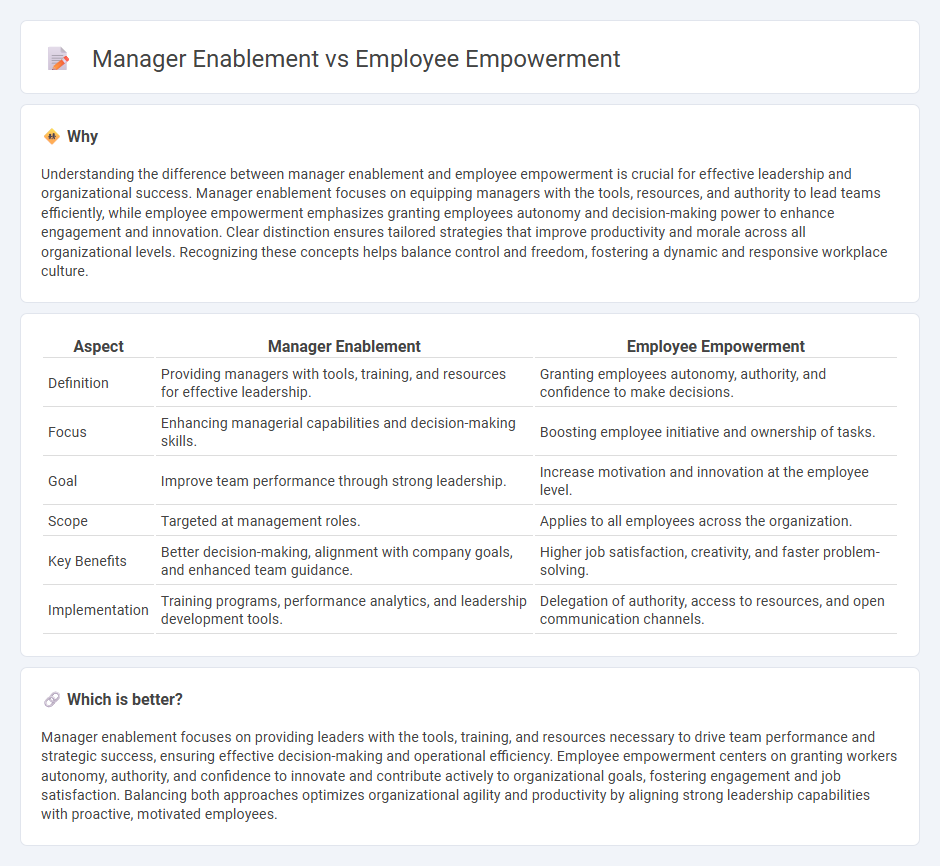
Manager enablement focuses on providing leaders with the tools, training, and resources necessary to effectively guide teams and drive organizational success. Employee empowerment emphasizes granting workers autonomy, decision-making authority, and confidence to contribute meaningfully to business outcomes. Explore the distinct roles of manager enablement and employee empowerment to enhance workplace dynamics and productivity.
Why it is important
Understanding the difference between manager enablement and employee empowerment is crucial for effective leadership and organizational success. Manager enablement focuses on equipping managers with the tools, resources, and authority to lead teams efficiently, while employee empowerment emphasizes granting employees autonomy and decision-making power to enhance engagement and innovation. Clear distinction ensures tailored strategies that improve productivity and morale across all organizational levels. Recognizing these concepts helps balance control and freedom, fostering a dynamic and responsive workplace culture.
Comparison Table
| Aspect | Manager Enablement | Employee Empowerment |
|---|---|---|
| Definition | Providing managers with tools, training, and resources for effective leadership. | Granting employees autonomy, authority, and confidence to make decisions. |
| Focus | Enhancing managerial capabilities and decision-making skills. | Boosting employee initiative and ownership of tasks. |
| Goal | Improve team performance through strong leadership. | Increase motivation and innovation at the employee level. |
| Scope | Targeted at management roles. | Applies to all employees across the organization. |
| Key Benefits | Better decision-making, alignment with company goals, and enhanced team guidance. | Higher job satisfaction, creativity, and faster problem-solving. |
| Implementation | Training programs, performance analytics, and leadership development tools. | Delegation of authority, access to resources, and open communication channels. |
Which is better?
Manager enablement focuses on providing leaders with the tools, training, and resources necessary to drive team performance and strategic success, ensuring effective decision-making and operational efficiency. Employee empowerment centers on granting workers autonomy, authority, and confidence to innovate and contribute actively to organizational goals, fostering engagement and job satisfaction. Balancing both approaches optimizes organizational agility and productivity by aligning strong leadership capabilities with proactive, motivated employees.
Connection
Manager enablement drives employee empowerment by equipping leaders with the skills, resources, and authority to support their teams effectively. Empowered managers foster a culture of trust and autonomy, which directly enhances employee confidence and decision-making capabilities. This interconnected dynamic boosts overall organizational productivity and innovation by aligning leadership empowerment with workforce engagement.
Key Terms
Decision-Making Authority
Employee empowerment grants individuals autonomy to make decisions directly affecting their work, fostering ownership and innovation across teams. Manager enablement equips supervisors with tools, training, and authority to support and guide their teams effectively, enhancing leadership and strategic alignment. Explore further to understand how balancing both approaches drives organizational success.
Autonomy Support
Employee empowerment emphasizes providing workers with autonomy support to enhance decision-making capabilities and foster intrinsic motivation. Manager enablement focuses on equipping leaders with tools and strategies to create environments that support employee autonomy, increasing engagement and productivity. Explore how autonomy support bridges employee empowerment and manager enablement for optimal organizational performance.
Leadership Facilitation
Employee empowerment enhances organizational performance by granting workers autonomy, encouraging innovation, and fostering accountability within teams. Manager enablement focuses on leadership facilitation by equipping managers with the tools, resources, and decision-making authority necessary to support and guide their employees effectively. Discover how balancing employee empowerment and manager enablement drives stronger leadership and operational success.
Source and External Links
Employee Empowerment: Definition, Benefits, and Examples - Upwork - Employee empowerment enables employees to take ownership of their work by offering training, encouraging feedback, and fostering a supportive culture that promotes creativity and engagement.
Employee empowerment: Benefits and strategies - Achievers - Employee empowerment involves trusting employees with freedom, tools, and support, enhanced through meaningful feedback, recognition, growth opportunities, and embedding empowerment into everyday culture.
What is employee empowerment and how to build an empowered ... - Culture Monkey - HR plays a key role in empowerment by developing training programs, promoting open communication, including employees in decision-making, and recognizing achievements to boost autonomy and engagement.
 dowidth.com
dowidth.com